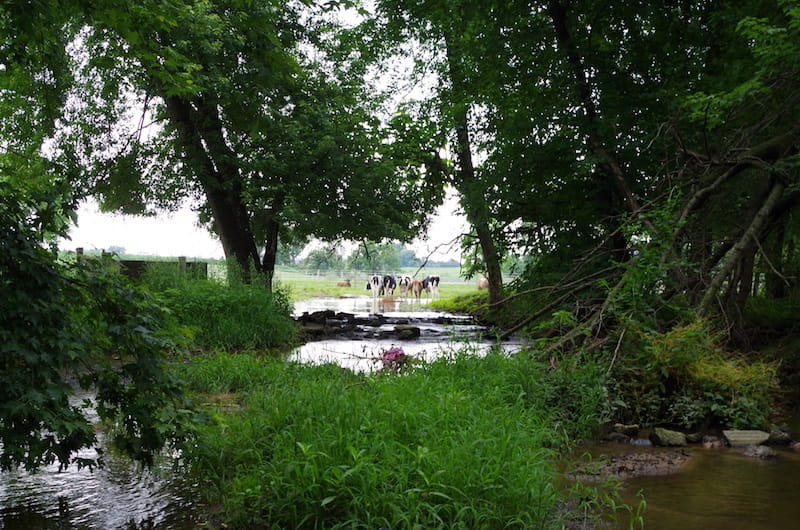Are We Really Protecting Rivers and Streams From Pollution? It’s Hard to Say, And That’s a Problem.
 By Emily Storz
By Emily Storz

- Drexel Selects New, World-Class Life Sciences Building at 3201 Cuthbert Street for Medical Research Operations
- Breakthrough on Gene Therapy for Hereditary Spastic Paraplegia
- Drexel Environmental Collaboratory Releases Cross-Sector Findings on Severe Weather Recovery Challenges
- Drexel Launches the Manuel Stamatakis Center for Alternative Investments at the LeBow College of Business

More public and private resources than ever are being directed to protecting and preserving aquatic ecosystems and watersheds. Whether mandated for land development, farming or in response to the growing severity and number of natural disasters – scientists from the Academy of Natural Sciences of Drexel University found evidence that decades of watershed restoration and mitigation projects have taken place, but their impact is mostly perceived; data is relatively undocumented — or simply missing.
In their report, entitled “Large-scale protection and restoration programs aimed at protecting stream ecosystem integrity: the role of science-based goal-setting, monitoring, and data management,” which was published recently online in Freshwater Science, Academy researchers and the Stroud Water Research Center attribute the dearth of data to a need for greater investment in planning, goal-setting, monitoring and documenting stages of mitigation programs throughout the watersheds.
Stefanie A. Kroll, PhD, an assistant research professor in Drexel’s department of Biodiversity, Earth & Environmental Science and one of the authors of the report encountered these challenges first hand while working on The Delaware River Watershed Initiative (DRWI).
“I was surprised to find a very small fraction of stream restoration projects that implemented agricultural best practices (BMPs) and storm water control (SCMs) – over the past few decades had produced and most importantly documented measurable change in physicochemical aspects of the streams targeted,” said Kroll.
Kroll and her collaborators at the Academy drew on their observations from seven years with the DRWI, and a review of similar projects across the region, to identify the main challenges of applying scientific planning and monitoring for restoration.
The most significant obstacles they found were:
- Lack of planning for implementation of a monitoring program
- Lack of considerations of geographic region or scale of project
- Failure to develop specific goals
- Limitations to the scope of projects, including long term monitoring, as a result of expectations from the funding agency
To address these challenges, the authors suggest a combination of setting a more stringent standard for monitoring the programs and partnering with established conservation groups to implement it.
“You don’t have to re-build the wheel, to solve this challenge,” said Kroll. “One solution is to use water restoration funding to leverage existing scientific and conservation organizations in the region to work to improve water quality and help measure its success.”
And when planning these programs, the authors note that it’s important to set an appropriate scope, both geographically and temporally, for the monitoring.
“The cumulative effects of small, restored watersheds can show greater results than similar-scale implementations spread out in large catchments,” said Kroll. “By choosing the right focus areas, even smaller zones within subwatersheds, can have a more critical impact than choosing to treat a larger portion of a stream network with more challenging conditions, evoking a true ‘less is more’ mentality.”
The authors suggest several types of monitoring programs, that could be scaled to a variety of sites and conditions, which would produce useable data for making comparative measurements over a time period in which the programs should be showing an effect.
What those effects are will vary from watershed to watershed, they acknowledge, so it’s equally important to develop specific mitigation and preservation goals that are realistic and appropriate for that particular watershed. Currently there are few data addressing what ecosystem parameters can or should be expected to change in response to river restoration.
“Defining degradation in context of a desired condition must be tailored to the objectives of a project,” said Kroll. “We need data to set realistic goals based on different criteria or examples from nearby restoration successes and potential factors that interfere with signals of recovery, like past land use, changes in farming/water practices and climate change.”
For example, Kroll and her team collect data differently from agencies that are checking on whether streams are attaining their designated use, but they want the data to be useful to agencies. They meet regularly with agencies from Pennsylvania and New Jersey, in addition to the Delaware River Basin Commission, to share findings and talk about ways to work together.
But the universal challenge, the study suggests, is that funding for these projects does not align with their scope. As a result, the efforts can end up being truncated or fail to produce results in the time allotted by the funding organization.
“Those who fund restoration activities generally provide resources for small projects or groups of small projects that are rarely combined or integrated as a part of a large long-term and comprehensive restoration plan,” said Kroll.
The authors suggest helping the funders better understand the scope of the project by reporting or meeting with them regularly; and doing their best to partner with community scientists and conservation groups to share data and best practices, which could help increase the cost-effectiveness and sustainability of monitoring programs.
Looking forward, the researchers are considering these protocols as blueprints for future monitoring programs. By sharing data and collaborating with regional partner organizations, monitoring programs will ideally be more efficient and collect more meaningful data that can be used for the creation of future restoration projects and the continual improvement of water quality across the board.
“There is no ‘one-size-fits-all’ approach to watershed restoration,” said Kroll. “But a framework that enables better planning, monitoring and management will help us better inform restoration practices to make limited funding more targeted and effective – insuring activities are achieving their intended benefits and ultimately improving water quality and preserving the integrity of our ecosystems.”
Drexel News is produced by
University Marketing and Communications.